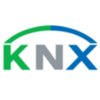 KNX Association
KNX AssociationKNX
What object flags are defined with KNX?
To what purpose do the KNX object flags serve, what types are there and how are they defined?
 KNX Association
KNX AssociationTo what purpose do the KNX object flags serve, what types are there and how are they defined?
With KNX, the object flags are defining the bus behavior of the representing object, thus each of them is defined with one of the 6 different flags:
The Communication flag (C-flag)
This flag represents that all of the defined flags are enabled for this object.
The Read flag (R-flag)
A device carrying this flag will react to the GroupValueRead telegram that is coming from a bus, thus sending back to the bus a GroupValueRead telegram.
The Transmit flag (T-flag)
A device with a T-flag object can transmit any object value, for example sending a GroupValueWrite telegram to the bus. A push-button object representing this means that this object has been manipulated.
The Write flag (W-flag)
This device object reacts back to a GroupValueWrite coming from the bus, meaning it will overwrite the object value. For a switch actuator, for example, this might mean that a certain relay representing these objects will be opened or closed.
The Update flag (U-flag)
A device with this object reacts to a GroupValueResponse telegram, capable of overwriting the object values.
The Initialization flag (I-flag)
This object will reset send a GroupValueRead telegram back to the bus, with the purpose to get the object value via a GroupValueResponse. One of the reasons it might be a power failure, bus or device reset requires via a telegram.
You know a better answer?
The question about KNX Association has already been answered, but there may be a better solution or alternative available by now. If you know it, answer the question now and increase your reputation as an industry expert in our B2B community.
 Related Questions
Related QuestionsWith which knx actuator can the screentronic blind be controlled ?
Hi,
With which knx actuator can the screentronic blind be controlled without using the controltronic actuator ?
Thanks
Non sending group address and Central functions?
I use one group address for central functions with multiple non-sending objects. When I write a value they are only updated after I read them...
How are KNX systems used to control lighting, heating, air conditioning and other functions?
How are KNX systems used to control lighting, heating, air conditioning and other functions?
Was the content helpful to you?